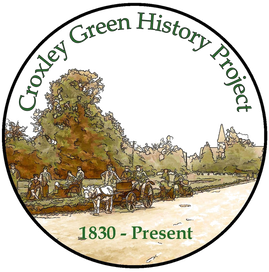Women's Social and Political Union
The Women’s Social and Political Union (WSPU) was founded in Manchester in October 1903. Emmeline Pankhurst founded the Women's Social and Political Union and her daughter, Christabel Pankhurst, was to become a stalwart member.
Manchester already had a women’s suffrage movement before October 1903 – Lydia Becker had founded the Manchester Women's Suffrage Committee. Many women who wanted the right to vote had put their faith in the Independent Labour Party (ILP) and local trade unions. Christabel Pankhurst had joined the NESWS in 1901 but by 1903 she had become wary about the ILP’s support for women’s political rights. Christabel believed that the ILP’s support for female suffrage was half-hearted and she looked for a different direction to take. Emmeline Pankhurst decided to set up a new women’s suffrage movement – and Christabel was keen to join.
Emmeline Pankhurst wanted a greater commitment to women’s political rights from the ILP. She wanted the ILP to simply state that women had the right to the same political status as men. The first primary role of the new Women’s Social and Political Union was to put pressure on the ILP. They were helped in this as a number of the members of the Women’s Social and Political Union were married to ILP members. From its start, the WSPU wanted to live by its motto: "Deeds, not words".
The Women’s Social and Political Union did not start out as a militant movement. In later years, former members of the WSPU claimed that the movement had been pushed into its militant stance by the intransigent behaviour of the government of the day.
In 1906, when Asquith’s Liberal Party came to power, the hopes of the WSPU were raised simply because the Liberal Party was seen as the party that would pioneer women’s political rights in Britain. The Women’s Social and Political Union believed that the Liberal Party by the very nature of liberalism would push forward political reform. When this did not happen, militancy became common place with regards to WSPU actions. In fact, militancy was not new to some members of the WSPU. Some of the older members had achieved some fame in the years before the WSPU had been formed. Dora Montefiore had urged civil disobedience in the 1890’s in the form of non-payment of taxes. In 1906, Montefiore had refused to pay her tax on the basis that "taxation without representation is tyranny". Her house was besieged for six weeks by bailiffs waiting to get out furniture valued to the amount of tax she owed.
In 1905, Christabel Pankhurst and Annie Kenney had created a disturbance in Manchester when they disrupted addresses by Winston Churchill and Sir Edward Grey – both prominent Liberals of the day. Many men had come to listen to their speeches. It was the norm of the day that speeches made by politicians and most other people were listened to in silence. Heckling was rare and frowned on. It was considered to be the most basic of courtesies to allow someone to express their views without interruption. Those who attended these political meetings tended to be supporters of those giving speeches. Therefore, by shouting out and interrupting the speakers went against the norm of the time. What Pankhurst and Kenney shouted out seems tame by today’s standards. They wanted to know where Churchill and Grey both stood with regards to women’s political rights. But what was controversial was how they made their protest.
First, many people, including many women, saw no place in politics for women. Therefore, by simply being at the meeting, Pankhurst and Kenney were going against social conventions. Secondly, their conduct at that meeting in Manchester tarred the public perception of women who were seeking political equality with men.
After unfurling a banner which read "Votes for Women", both Pankhurst and Kenney were arrested for a technical assault on a policeman. Both refused to pay the fine imposed on them, preferring to go to prison. This tactic, they believed, would give more headlines to their cause. Both women gambled on the newspapers of the time picking up on their story if they took this stance. In her autobiography Christabel wrote:
"This was the beginning of a campaign the like of which was never known in England, or for that matter in any other country….we interrupted a great many meetings……and were violently thrown out and insulted. Often we were painfully bruised and hurt."
The action taken by Pankhurst and Kenney was designed to shock. Their approach was in direct contrast to the way other suffragette movements went about their protests – the ‘normal’ procedure was to be genteel and polite. It was this direct approach that attracted so many young middle class women to the Women’s Social and Political Union.
Christabel Pankhurst saw the extension of the franchise to women as just a part of the whole plan of elevating the status of women in British society. If the government was not prepared to do it, then the actions of the WSPU would force its hand. Christabel wanted to see full female independence and a move away from what she called the "slave spirit" that many women lived in.
Militancy further split the WSPU away from other female movements. Esther Roper’s NESWS was against the militant tactics of the Women’s Social and Political Union. Roper believed that the WSPU was a dishonest group and that its actions would push back the rights of women rather than advance them. She also believed that the WSPU would not fool the public when it claimed that its arrested members were innocent victims of the police.
In fact, it is now generally accepted that Christabel’s actions did have a negative impact. Many working class women were shocked by militant tactics and they turned their backs on movements like the WSPU. The WSPU became the preserve of what can be described as middle class women. Therefore, the movement to advance the political status of women lost the very group that would have given it the numbers to give it some form of social clout. The more women in the movement would have given it more power – but he loss of the working class does explain why the WSPU did not become a mass movement among all classes.
Another reason why the Women’s Social and Political Union did not gain the support of the working class was because the WSPU was perceived to only want political equality – it was not seen as a movement that want full equality on all levels. To many working class women the WSPU wanted to give women political equality but did not want to address their social inequality. To many working class women the slogan "Votes for Women" did not actually mean a great deal. They lived in a society that paid them less than men for doing exactly the same job and where they were generally considered to be second class citizens regardless of their political rights.
To people like Sandra Holton, the WSPU lost sight of what it set out to do. In "Feminism and Democracy", Holton claims that the real divide between the many suffragette movements was that some believed purely in female political equality (the WSPU and NUWSS) while others advocated full adult political suffrage regardless of gender (such as the People’s Suffrage Federation).
The ‘danger’ associated with Women’s Social and Political Union also endangered their own meetings as these attracted thugs whose only desire was to stop and interrupt WSPU meetings. Conversely, when members of the WSPU attended other political meetings and made their views known, the police would frequently manhandle them to remove them from a meeting and little was done to prosecute those members of the police who might have overused their powers.
The militant action of the Women’s Social and Political Union fell into three distinct phases:
1) 1905 to 1908: disruption of political meetings. Any publicity was seen as good publicity.
2) 1908 to 1913: limited threats to public order. This included window breaking, chaining to railings, attacks on politicians etc. The idea was to get arrested, go on hunger strike and embarrass the government.
3) 1913 to 1914: attacks on the property of people opposed to female suffrage. This included churches and Westminster Abbey. The success of the "Cat and Mouse Act" led to this.
Manchester already had a women’s suffrage movement before October 1903 – Lydia Becker had founded the Manchester Women's Suffrage Committee. Many women who wanted the right to vote had put their faith in the Independent Labour Party (ILP) and local trade unions. Christabel Pankhurst had joined the NESWS in 1901 but by 1903 she had become wary about the ILP’s support for women’s political rights. Christabel believed that the ILP’s support for female suffrage was half-hearted and she looked for a different direction to take. Emmeline Pankhurst decided to set up a new women’s suffrage movement – and Christabel was keen to join.
Emmeline Pankhurst wanted a greater commitment to women’s political rights from the ILP. She wanted the ILP to simply state that women had the right to the same political status as men. The first primary role of the new Women’s Social and Political Union was to put pressure on the ILP. They were helped in this as a number of the members of the Women’s Social and Political Union were married to ILP members. From its start, the WSPU wanted to live by its motto: "Deeds, not words".
The Women’s Social and Political Union did not start out as a militant movement. In later years, former members of the WSPU claimed that the movement had been pushed into its militant stance by the intransigent behaviour of the government of the day.
In 1906, when Asquith’s Liberal Party came to power, the hopes of the WSPU were raised simply because the Liberal Party was seen as the party that would pioneer women’s political rights in Britain. The Women’s Social and Political Union believed that the Liberal Party by the very nature of liberalism would push forward political reform. When this did not happen, militancy became common place with regards to WSPU actions. In fact, militancy was not new to some members of the WSPU. Some of the older members had achieved some fame in the years before the WSPU had been formed. Dora Montefiore had urged civil disobedience in the 1890’s in the form of non-payment of taxes. In 1906, Montefiore had refused to pay her tax on the basis that "taxation without representation is tyranny". Her house was besieged for six weeks by bailiffs waiting to get out furniture valued to the amount of tax she owed.
In 1905, Christabel Pankhurst and Annie Kenney had created a disturbance in Manchester when they disrupted addresses by Winston Churchill and Sir Edward Grey – both prominent Liberals of the day. Many men had come to listen to their speeches. It was the norm of the day that speeches made by politicians and most other people were listened to in silence. Heckling was rare and frowned on. It was considered to be the most basic of courtesies to allow someone to express their views without interruption. Those who attended these political meetings tended to be supporters of those giving speeches. Therefore, by shouting out and interrupting the speakers went against the norm of the time. What Pankhurst and Kenney shouted out seems tame by today’s standards. They wanted to know where Churchill and Grey both stood with regards to women’s political rights. But what was controversial was how they made their protest.
First, many people, including many women, saw no place in politics for women. Therefore, by simply being at the meeting, Pankhurst and Kenney were going against social conventions. Secondly, their conduct at that meeting in Manchester tarred the public perception of women who were seeking political equality with men.
After unfurling a banner which read "Votes for Women", both Pankhurst and Kenney were arrested for a technical assault on a policeman. Both refused to pay the fine imposed on them, preferring to go to prison. This tactic, they believed, would give more headlines to their cause. Both women gambled on the newspapers of the time picking up on their story if they took this stance. In her autobiography Christabel wrote:
"This was the beginning of a campaign the like of which was never known in England, or for that matter in any other country….we interrupted a great many meetings……and were violently thrown out and insulted. Often we were painfully bruised and hurt."
The action taken by Pankhurst and Kenney was designed to shock. Their approach was in direct contrast to the way other suffragette movements went about their protests – the ‘normal’ procedure was to be genteel and polite. It was this direct approach that attracted so many young middle class women to the Women’s Social and Political Union.
Christabel Pankhurst saw the extension of the franchise to women as just a part of the whole plan of elevating the status of women in British society. If the government was not prepared to do it, then the actions of the WSPU would force its hand. Christabel wanted to see full female independence and a move away from what she called the "slave spirit" that many women lived in.
Militancy further split the WSPU away from other female movements. Esther Roper’s NESWS was against the militant tactics of the Women’s Social and Political Union. Roper believed that the WSPU was a dishonest group and that its actions would push back the rights of women rather than advance them. She also believed that the WSPU would not fool the public when it claimed that its arrested members were innocent victims of the police.
In fact, it is now generally accepted that Christabel’s actions did have a negative impact. Many working class women were shocked by militant tactics and they turned their backs on movements like the WSPU. The WSPU became the preserve of what can be described as middle class women. Therefore, the movement to advance the political status of women lost the very group that would have given it the numbers to give it some form of social clout. The more women in the movement would have given it more power – but he loss of the working class does explain why the WSPU did not become a mass movement among all classes.
Another reason why the Women’s Social and Political Union did not gain the support of the working class was because the WSPU was perceived to only want political equality – it was not seen as a movement that want full equality on all levels. To many working class women the WSPU wanted to give women political equality but did not want to address their social inequality. To many working class women the slogan "Votes for Women" did not actually mean a great deal. They lived in a society that paid them less than men for doing exactly the same job and where they were generally considered to be second class citizens regardless of their political rights.
To people like Sandra Holton, the WSPU lost sight of what it set out to do. In "Feminism and Democracy", Holton claims that the real divide between the many suffragette movements was that some believed purely in female political equality (the WSPU and NUWSS) while others advocated full adult political suffrage regardless of gender (such as the People’s Suffrage Federation).
The ‘danger’ associated with Women’s Social and Political Union also endangered their own meetings as these attracted thugs whose only desire was to stop and interrupt WSPU meetings. Conversely, when members of the WSPU attended other political meetings and made their views known, the police would frequently manhandle them to remove them from a meeting and little was done to prosecute those members of the police who might have overused their powers.
The militant action of the Women’s Social and Political Union fell into three distinct phases:
1) 1905 to 1908: disruption of political meetings. Any publicity was seen as good publicity.
2) 1908 to 1913: limited threats to public order. This included window breaking, chaining to railings, attacks on politicians etc. The idea was to get arrested, go on hunger strike and embarrass the government.
3) 1913 to 1914: attacks on the property of people opposed to female suffrage. This included churches and Westminster Abbey. The success of the "Cat and Mouse Act" led to this.


